
The Atlantic Ocean is the second-largest of the world's five oceans, with an area of about 85,133,000 km2 (32,870,000 sq mi). It covers approximately 17% of Earth's surface and about 24% of its water surface area. During the Age of Discovery, it was known for separating the New World of the Americas from the Old World of Afro-Eurasia.

Puffins are any of three species of small alcids (auks) in the bird genus Fratercula. These are pelagic seabirds that feed primarily by diving in the water. They breed in large colonies on coastal cliffs or offshore islands, nesting in crevices among rocks or in burrows in the soil. Two species, the tufted puffin and horned puffin, are found in the North Pacific Ocean, while the Atlantic puffin is found in the North Atlantic Ocean.

Clam is a common name for several kinds of bivalve molluscs. The word is often applied only to those that are edible and live as infauna, spending most of their lives halfway buried in the sand of the seafloor or riverbeds. Clams have two shells of equal size connected by two adductor muscles and have a powerful burrowing foot. They live in both freshwater and marine environments; in salt water they prefer to burrow down into the mud and the turbidity of the water required varies with species and location; the greatest diversity of these is in North America.

An ocean current is a continuous, directed movement of seawater generated by a number of forces acting upon the water, including wind, the Coriolis effect, breaking waves, cabbeling, and temperature and salinity differences. Depth contours, shoreline configurations, and interactions with other currents influence a current's direction and strength. Ocean currents are primarily horizontal water movements.

The harbour porpoise is one of eight extant species of porpoise. It is one of the smallest species of cetacean. As its name implies, it stays close to coastal areas or river estuaries, and as such, is the most familiar porpoise to whale watchers. This porpoise often ventures up rivers, and has been seen hundreds of kilometres from the sea. The harbour porpoise may be polytypic, with geographically distinct populations representing distinct races: P. p. phocoena in the North Atlantic and West Africa, P. p. relicta in the Black Sea and Sea of Azov, an unnamed population in the northwestern Pacific and P. p. vomerina in the northeastern Pacific.

Chamaecyparis thyoides, a species of Cupressaceae, is native to the Atlantic coast of North America and is found from southern Maine to Georgia and along the Gulf of Mexico coast from Florida to Mississippi. It is one of two species of Chamaecyparis found in North America. C. thyoides resides on the East Coast and C. lawsoniana can be found on the West Coast. There are two geographically isolated subspecies, treated by some botanists as distinct species, by others at just varietal rank: Chamaecyparis thyoides thyoides and Chamaecyparis thyoides henryae (H.L.Li) E.Murray The species grows in forested wetlands where they tend to dominate the canopy. The trees are associated with a wide variety of other wetland species because of their wide north-south range. The remaining populations are now found mostly in remote locations that would be difficult to harvest, so its popularity as a source of lumber has decreased.

The Atlantic salmon is a species of ray-finned fish in the family Salmonidae. It is the third largest of the Salmonidae, behind Siberian taimen and Pacific Chinook salmon, growing up to a meter in length. Atlantic salmon are found in the northern Atlantic Ocean and in rivers that flow into it. Most populations are anadromous, hatching in streams and rivers but moving out to sea as they grow where they mature, after which the adults seasonally move upstream again to spawn.

Members of the genus Lophius, also sometimes called monkfish, fishing-frogs, frog-fish, and sea-devils, are various species of lophiid anglerfishes found in the Atlantic and Indian Oceans. Lophius is known as the "monk" or "monkfish" to the North Sea and North Atlantic fishermen, a name which also belongs to Squatina squatina, the angelshark, a type of shark. The North European species is Lophius piscatorius, and the Mediterranean species is Lophius budegassa.
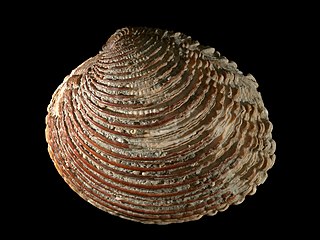
The Veneridae or venerids, common name: Venus clams, are a very large family of minute to large, saltwater clams, marine bivalve molluscs. Over 500 living species of venerid bivalves are known, most of which are edible, and many of which are exploited as food sources.

The Atlantic Flyway is a major north-south flyway for migratory birds in North America. The route generally starts in Greenland, then follows the Atlantic coast of Canada, then south down the Atlantic Coast of the United States to the tropical areas of South America and the Caribbean. Every year, migratory birds travel up and down this route following food sources, heading to breeding grounds, or traveling to overwintering sites.

Dosinia is a genus of saltwater clams, marine bivalve molluscs in the family Veneridae, subfamily Dosiniinae Deshayes, 1853. The shell of Dosinia species is disc-like in shape, usually white, and therefore is reminiscent of the shells of Lucinid bivalves.
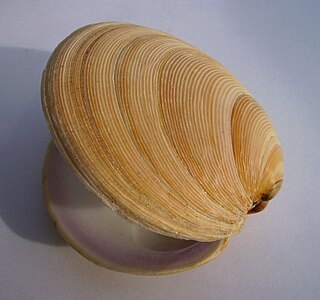
Dosinia anus, commonly named the ringed dosinia, coarse dosinia, coarse biscuit shell and tuangi-haruru, in the Māori language, is a species of saltwater clam, a marine bivalve mollusc in the family Veneridae, the venus clams. The species is common to both of the main islands of New Zealand, where it is the largest and heaviest species in the genus, occasionally exceeding 80 mm in diameter. It buries itself in clean fine sandy substrata, sub-tidally down to 15 m deep.

The Atlantic surf clam, also called the bar clam, hen clam, skimmer or simply sea clam, is a very large, edible, saltwater clam or marine bivalve mollusk in the family Mactridae. It is one of the most commonly found species of bivalves in the western Atlantic Ocean. Able to reach sizes between 7.9 and 8.9 inches in length, Atlantic surf clams are much larger than Spisula solida, which also resides in the eastern Atlantic coastal waters. Atlantic surf clams reproduce in late summer, when the water temperatures peak.
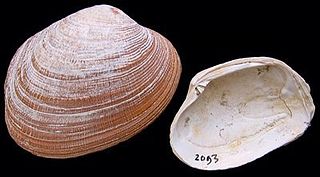
The grooved carpet shell, or Palourde clam, Ruditapes decussatus, or Venerupis decussatus, is a clam in the family Veneridae. It is distributed worldwide and is highly prized due to its ecological and economic interest. It has been proposed as a bioindicator.
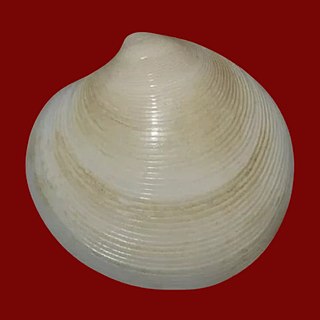
Dosinia concentrica, common name the West Indian dosinia, is a species of saltwater clam, a marine bivalve mollusc in the family Veneridae. This species is found in Caribbean waters, ranging from the West Indies to Brazil.

Dosinia discus, or the disk dosinia, is a species of bivalve mollusc in the family Veneridae. It can be found along the Atlantic coast of North America, ranging from Virginia to Florida.

Dosinia dunkeri is a species of saltwater clam, a marine bivalve mollusc in the family Veneridae.
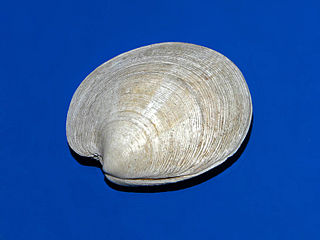
Dosinia exoleta, common name the rayed artemis, is a saltwater clam, a marine bivalve mollusc in the family Veneridae, the venus clams.
















